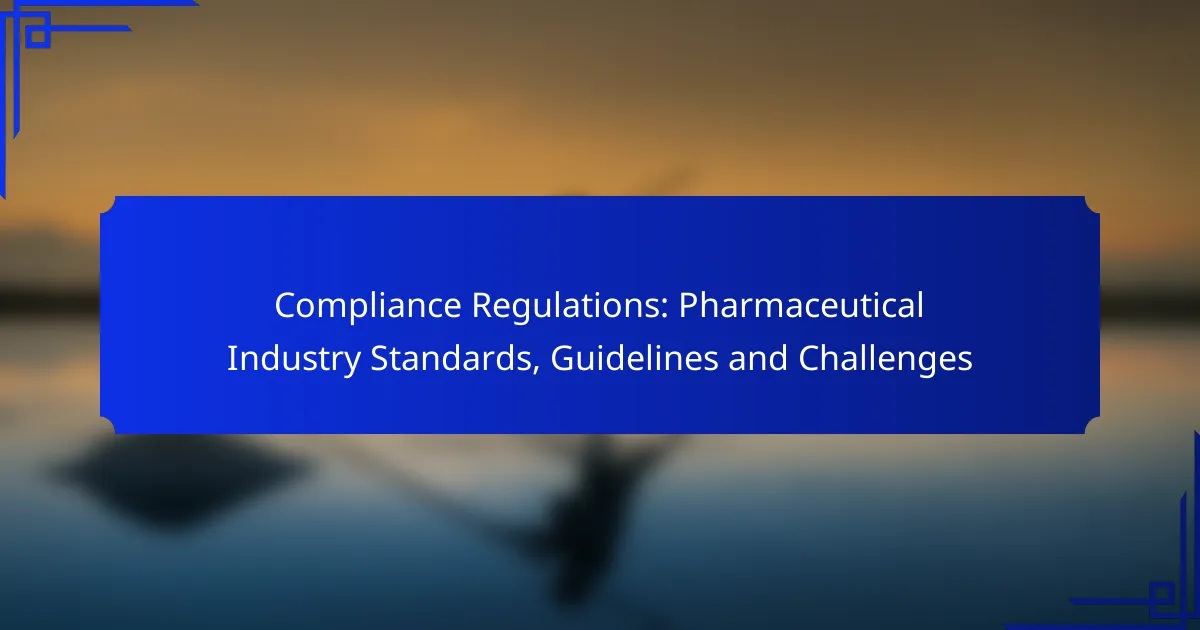The pharmaceutical industry is subject to stringent compliance regulations designed to ensure the safety, efficacy, and quality of medications. Adhering to these standards is essential for public health and involves a multifaceted approach, including audits, training, and quality management systems. However, companies face significant challenges in navigating complex regulations, managing resources, and adapting to technological advancements in a global market.
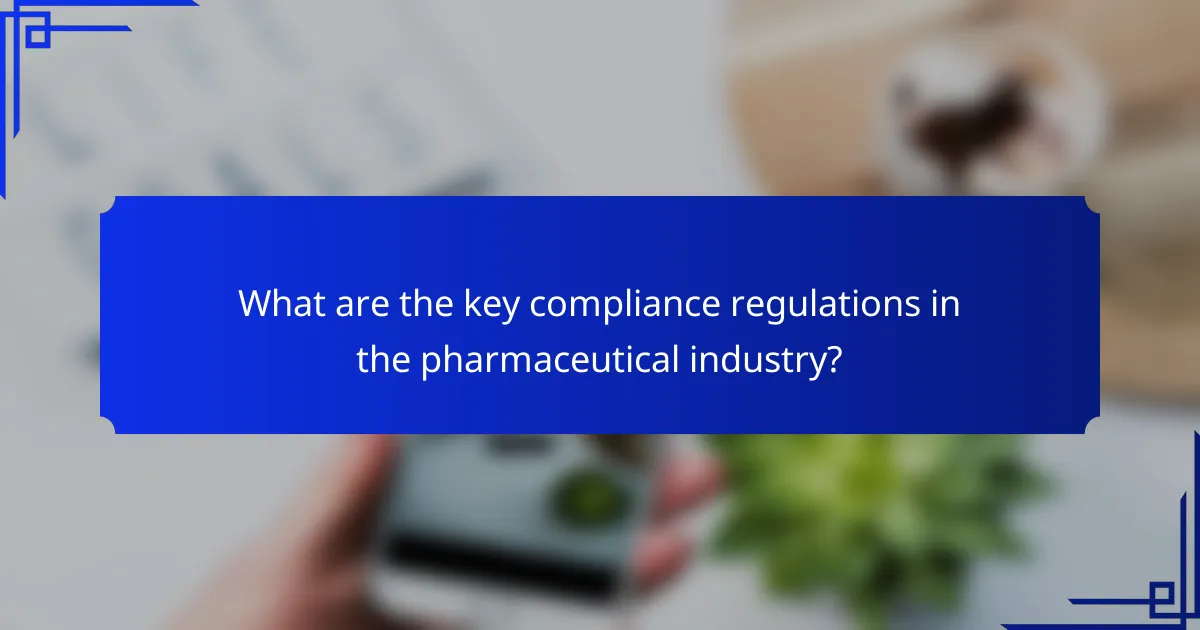
What are the key compliance regulations in the pharmaceutical industry?
The pharmaceutical industry is governed by several key compliance regulations that ensure the safety, efficacy, and quality of medications. These regulations are critical for maintaining public health and involve various standards set by regulatory bodies across different regions.
FDA regulations
The U.S. Food and Drug Administration (FDA) enforces regulations that pharmaceutical companies must follow to ensure drug safety and efficacy. Key components include the New Drug Application (NDA) process, which requires extensive clinical trial data, and adherence to Good Manufacturing Practices (GMP).
Companies must also comply with labeling requirements, ensuring that all information provided to healthcare professionals and patients is clear and accurate. Regular inspections and audits by the FDA help maintain compliance and identify potential issues early.
EMA guidelines
The European Medicines Agency (EMA) provides guidelines that govern the approval and monitoring of pharmaceutical products in the European Union. These guidelines emphasize the need for comprehensive clinical data and risk management plans to ensure patient safety.
Pharmaceutical companies must navigate the centralized and decentralized procedures for drug approval, which can vary significantly. Understanding these processes is crucial for timely market access and compliance with EU regulations.
ICH standards
The International Council for Harmonisation (ICH) develops standards that aim to harmonize regulatory requirements across different regions, including the U.S., EU, and Japan. ICH guidelines cover various aspects of drug development, including safety, efficacy, and quality.
Adhering to ICH standards can streamline the approval process and reduce duplication of efforts in clinical trials. Companies should familiarize themselves with ICH guidelines to enhance their global compliance strategies.
GxP requirements
Good Practice (GxP) regulations encompass a range of quality guidelines, including Good Laboratory Practice (GLP), Good Clinical Practice (GCP), and Good Distribution Practice (GDP). These practices ensure that pharmaceutical products are consistently produced and controlled according to quality standards.
Compliance with GxP is essential for maintaining product integrity throughout the lifecycle, from research and development to distribution. Regular training and audits can help companies stay compliant and avoid costly penalties.
HIPAA considerations
The Health Insurance Portability and Accountability Act (HIPAA) sets standards for protecting sensitive patient information in the U.S. Pharmaceutical companies must ensure that any data collected during clinical trials or patient interactions complies with HIPAA regulations.
Implementing robust data security measures and training staff on privacy practices are critical steps to avoid breaches and maintain compliance. Companies should regularly review their policies to adapt to any changes in HIPAA regulations.
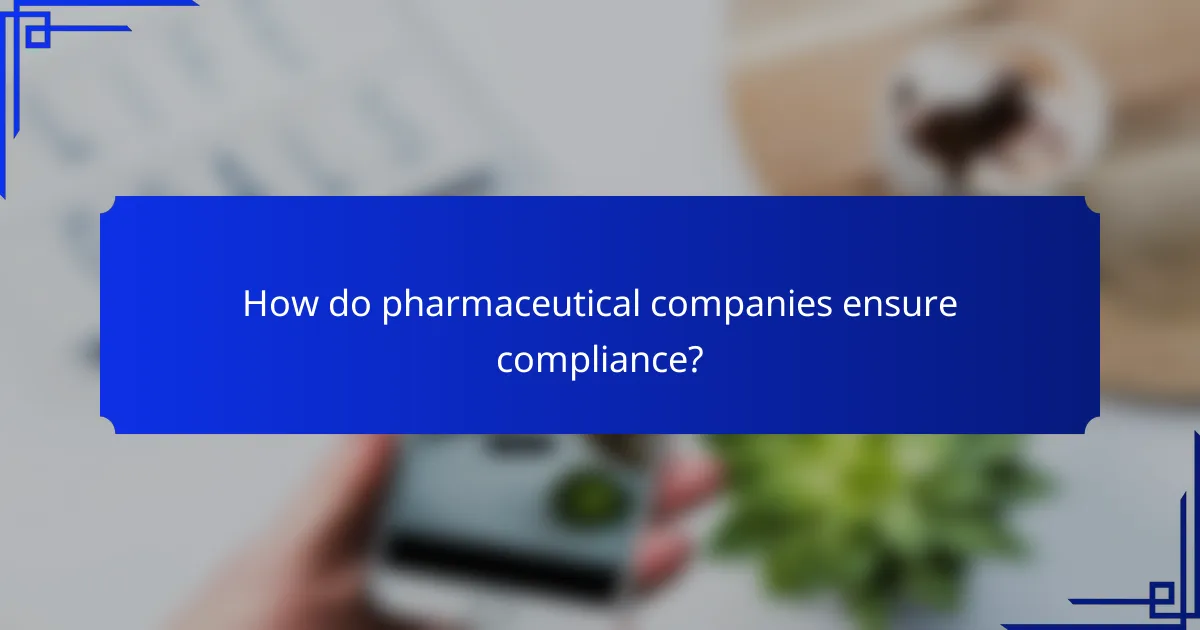
How do pharmaceutical companies ensure compliance?
Pharmaceutical companies ensure compliance through a combination of regular audits, comprehensive training programs, robust quality management systems, and meticulous documentation practices. These strategies help maintain adherence to industry standards and regulations, ultimately safeguarding public health.
Regular audits
Regular audits are essential for identifying compliance gaps and ensuring adherence to regulatory standards. These audits can be internal or external, with external audits often conducted by regulatory bodies or third-party organizations.
Typically, audits assess various aspects such as manufacturing processes, quality control measures, and record-keeping practices. Companies should schedule audits at least annually, but more frequent audits may be necessary for high-risk areas.
Training programs
Training programs are critical for keeping employees informed about compliance requirements and best practices. These programs should cover topics such as Good Manufacturing Practices (GMP), safety protocols, and regulatory updates.
Effective training should be ongoing, with refresher courses offered regularly to ensure that staff remain knowledgeable about evolving standards. Engaging training methods, such as workshops and e-learning modules, can enhance retention and application of compliance knowledge.
Quality management systems
A robust quality management system (QMS) is vital for ensuring compliance throughout the pharmaceutical production process. A QMS helps organizations systematically manage quality-related activities, from product development to post-market surveillance.
Key components of a QMS include risk management, process validation, and continuous improvement initiatives. Implementing a QMS can help identify potential compliance issues early, reducing the risk of costly recalls or regulatory penalties.
Documentation practices
Meticulous documentation practices are fundamental for demonstrating compliance with regulatory requirements. Proper documentation includes maintaining accurate records of manufacturing processes, quality control tests, and employee training.
Companies should establish clear protocols for document management, ensuring that records are easily accessible and securely stored. Regular reviews of documentation practices can help identify areas for improvement and ensure compliance with applicable regulations.
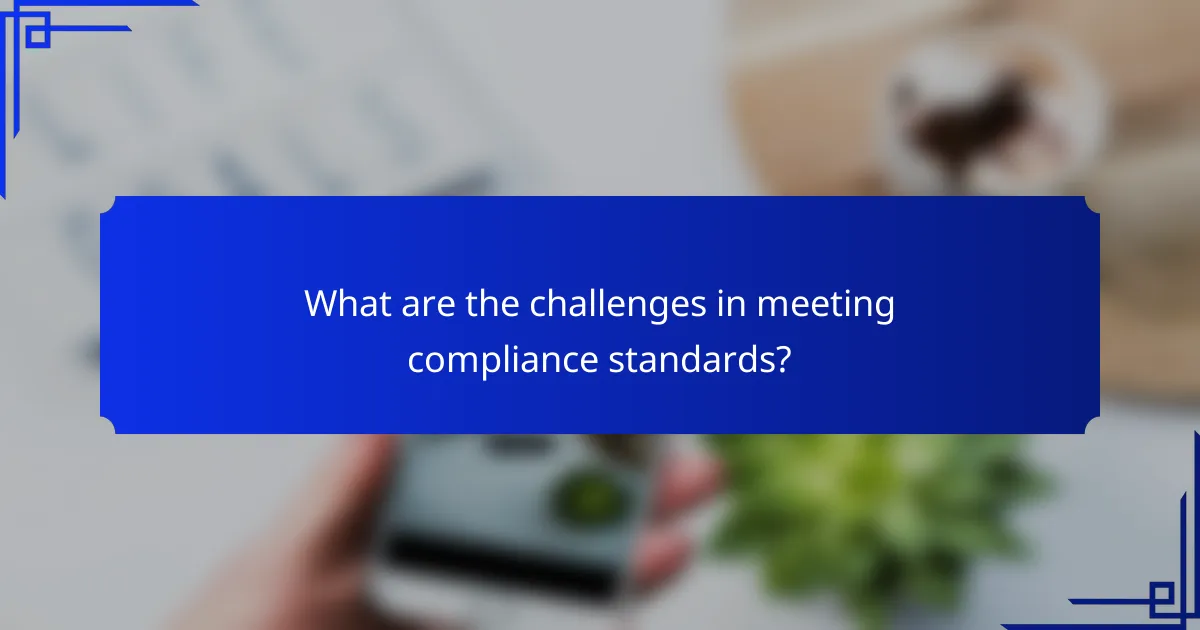
What are the challenges in meeting compliance standards?
Meeting compliance standards in the pharmaceutical industry presents several challenges, including navigating complex regulations, managing resource allocation, adapting to rapid technological changes, and addressing global market variations. These factors can significantly impact a company’s ability to maintain compliance and ensure product safety and efficacy.
Complex regulations
The pharmaceutical industry is governed by a myriad of complex regulations that vary by country and region. Companies must stay updated on guidelines from organizations such as the FDA in the United States or EMA in Europe, which can change frequently. Understanding these regulations requires dedicated expertise and can lead to significant compliance costs.
To manage these complexities, companies should invest in compliance training for staff and consider hiring regulatory affairs specialists. Regular audits can also help identify gaps in compliance and ensure adherence to the latest standards.
Resource allocation
Effective resource allocation is crucial for compliance, as it involves dedicating sufficient personnel, time, and financial resources to meet regulatory requirements. Many companies struggle to balance compliance efforts with other business priorities, which can lead to inadequate oversight and increased risk of non-compliance.
To optimize resource allocation, organizations should conduct a thorough assessment of their compliance needs and prioritize investments in areas that directly impact regulatory adherence. This may include technology upgrades, hiring additional staff, or enhancing training programs.
Rapid technological changes
The pace of technological advancement in the pharmaceutical sector can outstrip existing compliance frameworks. New technologies, such as artificial intelligence and blockchain, offer significant benefits but also introduce new compliance challenges that must be addressed. Companies must adapt their compliance strategies to incorporate these innovations while ensuring they meet regulatory standards.
To navigate these changes, businesses should engage in continuous learning and development, keeping abreast of technological trends and their implications for compliance. Collaborating with technology providers can also help ensure that new systems are compliant from the outset.
Global market variations
Operating in a global market means that pharmaceutical companies must contend with varying compliance standards across different countries. Each region may have its own regulatory bodies, guidelines, and enforcement practices, complicating the compliance landscape. This can lead to challenges in product registration, marketing, and distribution.
To effectively manage global compliance, companies should develop a comprehensive understanding of the regulatory environments in each market they operate in. Establishing local partnerships or consulting with experts can provide valuable insights and facilitate smoother compliance processes across borders.
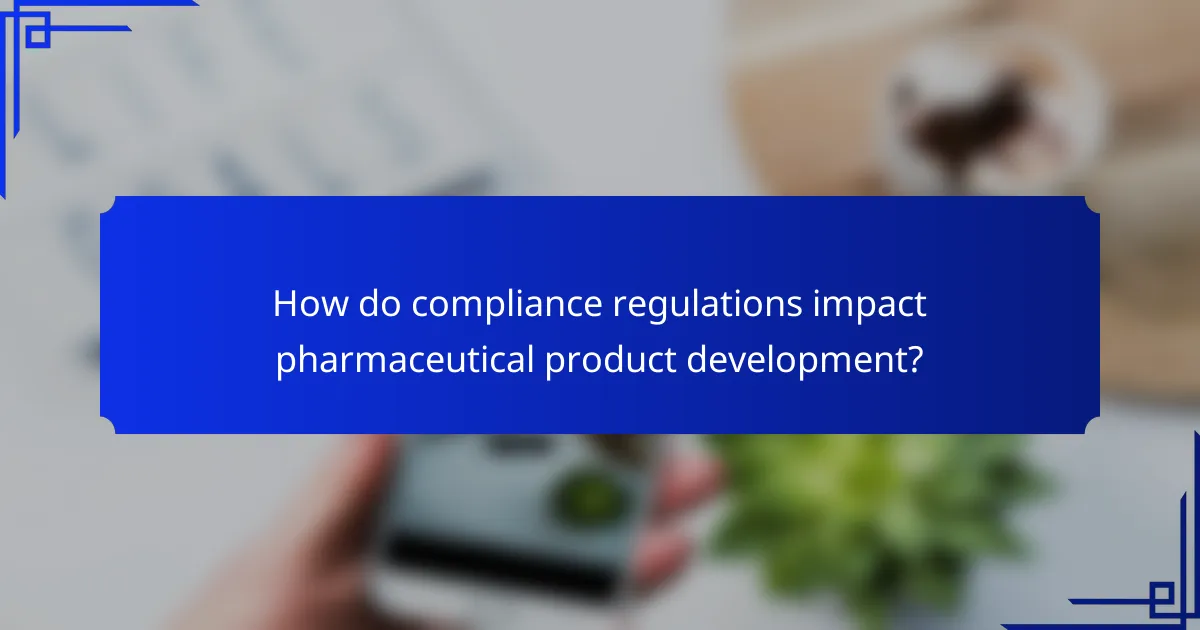
How do compliance regulations impact pharmaceutical product development?
Compliance regulations significantly influence pharmaceutical product development by establishing standards that ensure safety, efficacy, and quality. These regulations can lead to extended timelines, increased costs, and potential market access delays, all of which must be carefully managed throughout the development process.
Extended timelines
Compliance regulations often result in longer development timelines for pharmaceutical products. This is primarily due to the need for extensive testing, documentation, and regulatory approvals before a product can reach the market. For instance, clinical trials may take several years to complete, as they must adhere to strict protocols and guidelines.
Pharmaceutical companies should anticipate these extended timelines when planning their development strategies. Engaging with regulatory bodies early in the process can help clarify requirements and streamline approvals, potentially reducing delays.
Increased costs
Adhering to compliance regulations can lead to significantly increased costs in pharmaceutical product development. Expenses arise from rigorous testing, quality assurance processes, and the need for specialized personnel to manage compliance. Companies may spend millions of dollars on regulatory submissions and ongoing compliance monitoring.
To mitigate these costs, firms can invest in efficient project management and compliance tracking systems. Prioritizing early-stage compliance planning can also help avoid costly rework and delays later in the development process.
Market access delays
Compliance regulations can create barriers to timely market access for new pharmaceutical products. Delays may occur as companies navigate the complex approval processes required by regulatory agencies, which can vary by region. For example, obtaining approval from the U.S. Food and Drug Administration (FDA) or the European Medicines Agency (EMA) can take several months to years.
To address potential market access delays, companies should conduct thorough market assessments and engage with regulatory authorities to understand specific requirements. Developing a clear regulatory strategy can help streamline the approval process and facilitate quicker entry into the market.

What are the best practices for navigating compliance in the pharmaceutical sector?
Best practices for navigating compliance in the pharmaceutical sector include establishing robust internal processes, staying informed about regulations, and fostering a culture of compliance. These practices help ensure adherence to industry standards and mitigate risks associated with non-compliance.
Implementing proactive compliance strategies
Proactive compliance strategies involve anticipating regulatory changes and integrating compliance into the business model. Companies should conduct regular audits, risk assessments, and training programs to identify potential compliance gaps before they become issues.
Utilizing technology can streamline compliance efforts. For example, implementing software solutions for tracking regulatory changes or managing documentation can enhance efficiency and accuracy. Regularly updating these systems ensures that compliance measures remain effective and relevant.
Engaging with regulatory bodies
Engaging with regulatory bodies is crucial for maintaining compliance in the pharmaceutical industry. Establishing open lines of communication can provide valuable insights into upcoming regulations and expectations. Regular meetings or consultations can help clarify compliance requirements and foster a collaborative relationship.
Participating in industry forums and working groups can also enhance understanding of regulatory trends. These platforms allow companies to share experiences and best practices, ultimately leading to improved compliance strategies. Staying connected with regulatory updates helps organizations adapt swiftly to changes in the compliance landscape.
